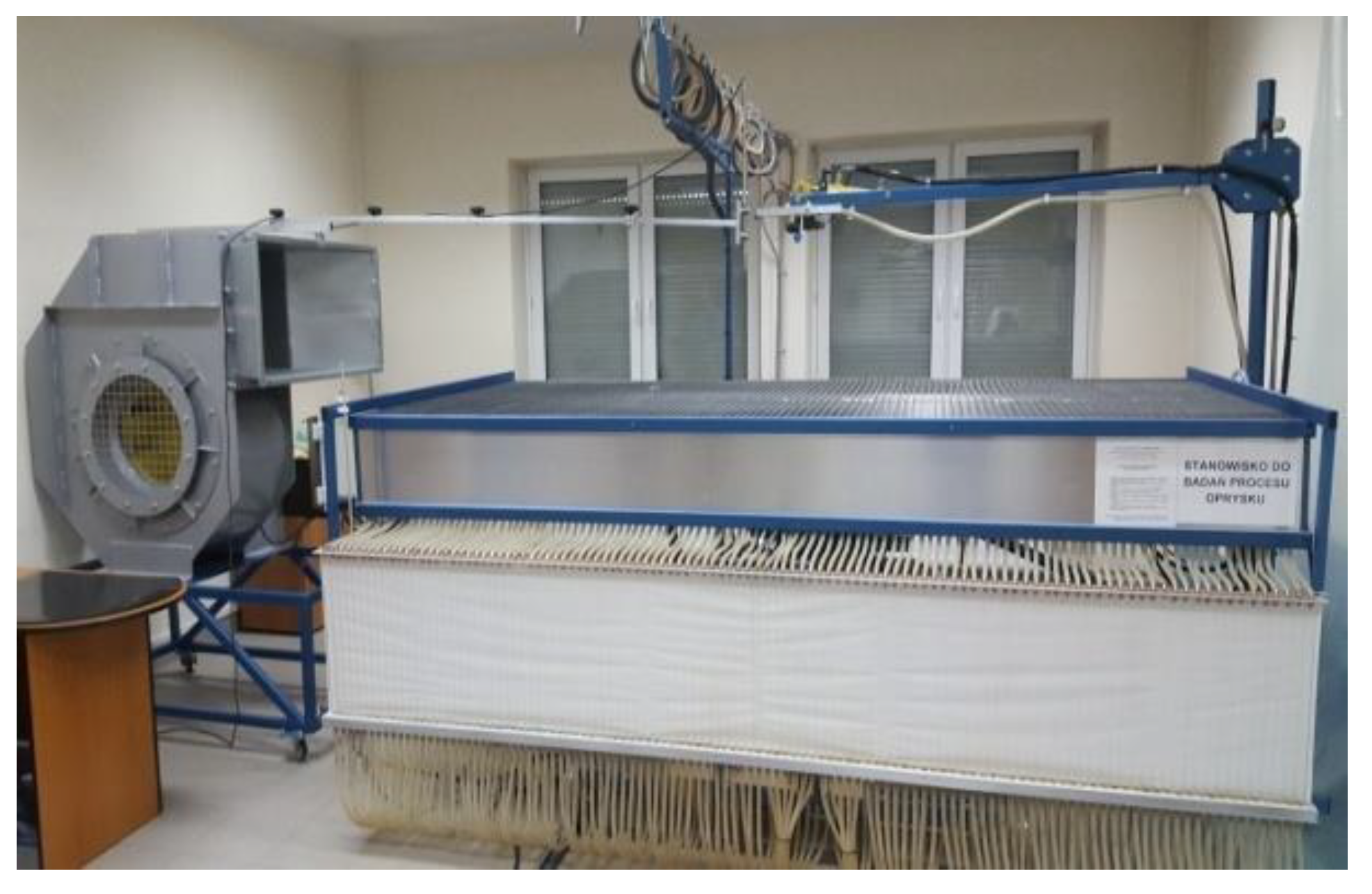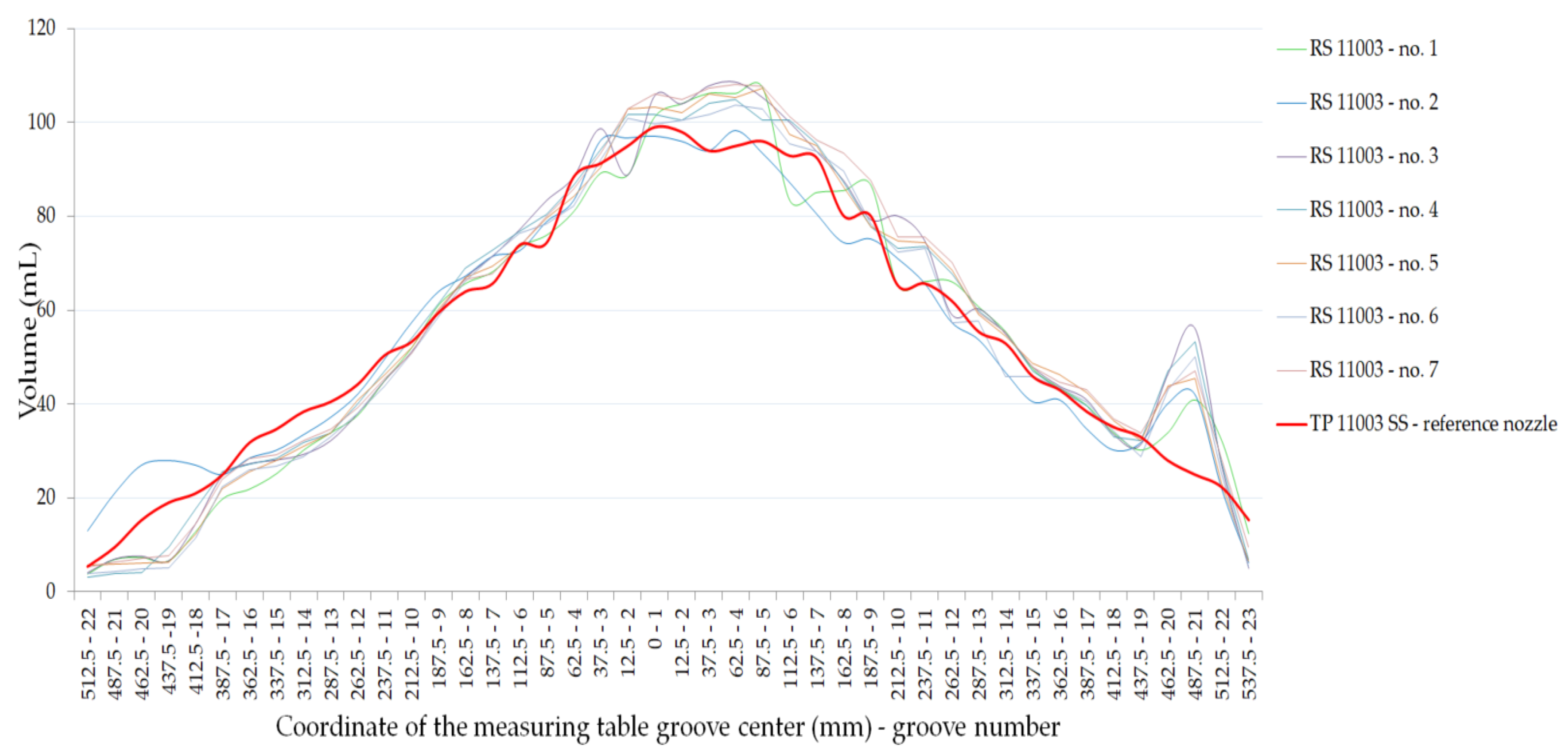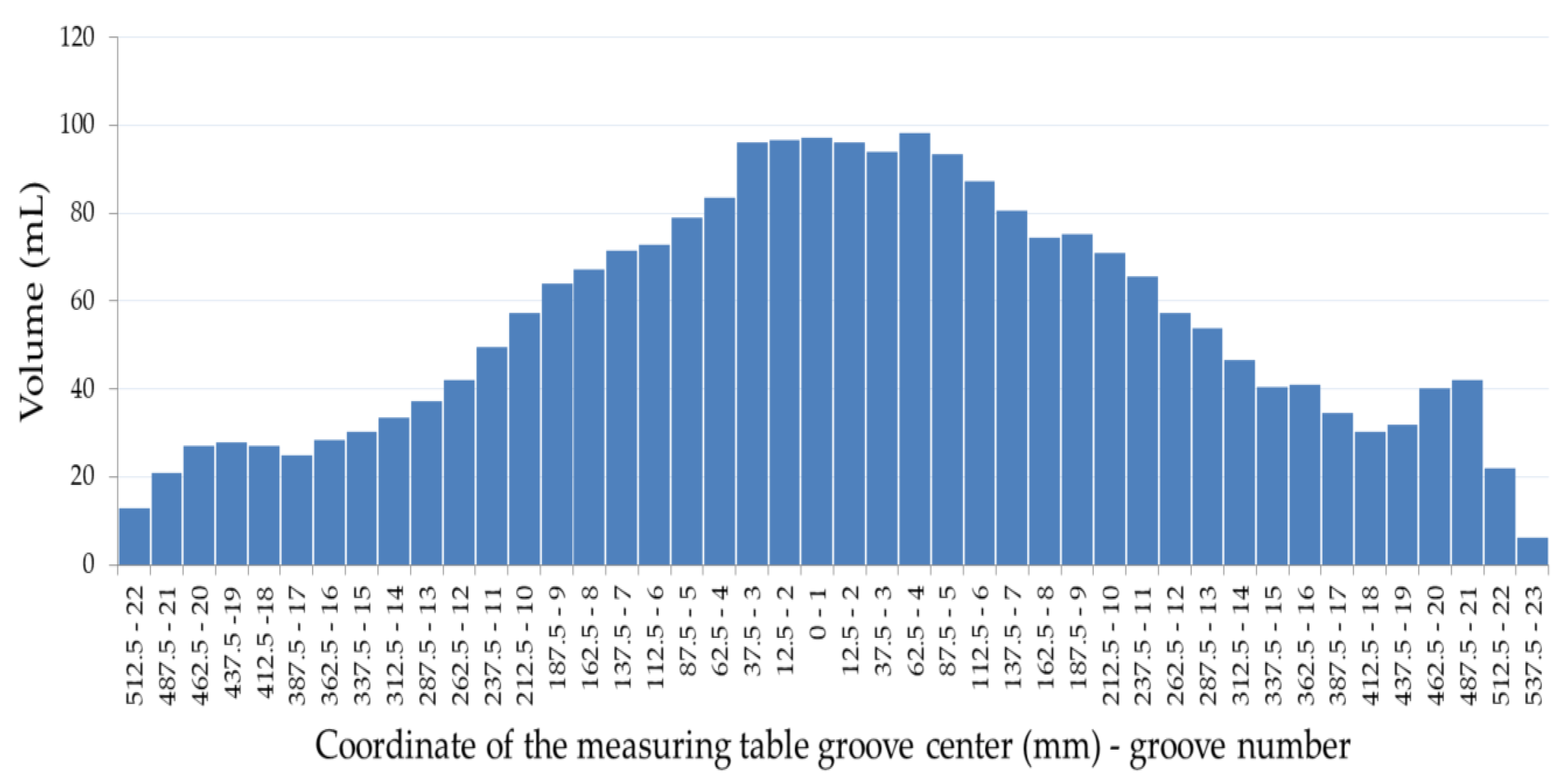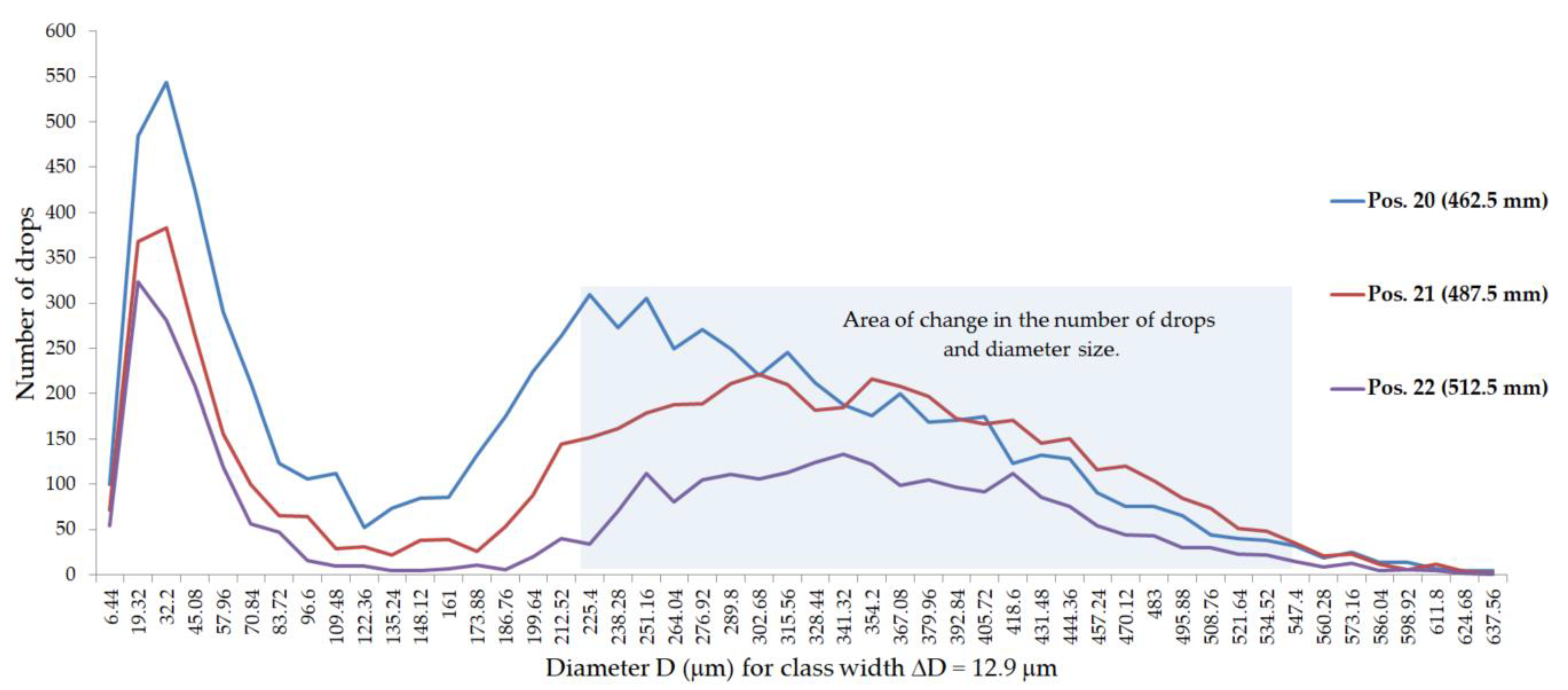Analysis of Volume Distribution and Evaluation of the Spraying Spectrum in Terms of Spraying Quality
Abstract
:1. Introduction
2. Materials and Methods
- The working medium was pure water and its temperature was 20 ± 2 °C;
- During measurements, a constant value of the spraying boom height above the measuring table surface of 0.4 m and working pressure of 3 bar were maintained;
- The duration of each measurement was 120 s;
- The accuracy of liquid volume reading in a single measuring vessel was ±1 mL;
- The ambient temperature during tests was 20 ± 2 °C, with relative humidity of 40%–80%;
- The accuracy of the working pressure reading was ±0.1 bar;
- The accuracy of the nozzle’s height reading above the measuring table was ±0.005 m;
- The accuracy of the nozzle’s angle reading in relation to the horizontal was ±1° [15].
3. Results and Discussion
4. Conclusions
- The tested nozzles sufficiently meet the generalized criteria regarding macroparameters (unit flow rate, CV coefficient) and microparameters, including qualification in the field of optimal fraction for produced droplets at the medium level (236–340 µm). This is also confirmed by the results of numerous studies carried out in other scientific centers and research institutions.
- Pronounced changes in the nature of the volume distribution (volume increase) observed in specific bands of the sprayed stream during the nozzle tests caused a significant change in droplet size, ranging from the medium level for the assessment of the entire stream to coarse or even very coarse droplets. The assembly of such streams emitted by nozzles located on the spraying boom can lead to the synergistic effect of the described disturbances in the considered areas and can contribute to a significant deterioration in the quality and effectiveness of spraying. The effects of poor spraying quality include reduced treatment effectiveness (reduced pest or disease control) or crop damage (overdose of a plant protection product). These effects can also lead to environmental hazards and economic losses.
- In cases where the volume distribution shows a clear and local change in character despite a positive verification result, the authors recommend carrying out additional tests, consisting of spot measurement of droplet characteristics in individual bands of the liquid stream corresponding to the width of a single groove of a grooved table.
- The Doppler laser anemometry method can be used to assess the lateral distribution of liquids on sprayed surfaces and to determine the corresponding value of the CV coefficient as an alternative to analogous measurements on a grooved table. This is confirmed by the results presented in Figure 10.
Author Contributions
Funding
Conflicts of Interest
References
- Sikkema, P.H.; Brown, L.; Shropshire, C.; Spieser, H.; Soltani, N. Flat fan and air induction nozzles affect soybean herbicide efficacy. Weed Biol. Manag. 2008, 8, 31–38. [Google Scholar] [CrossRef]
- Balsari, P.; Grella, M.; Marucco, P.; Matta, F.; Miranda-Fuentes, A. Assessing the influence of air speed and liquid flow rate on the droplet size and homogeneity in pneumatic spraying. Pest Manag. Sci. 2019, 75, 366–379. [Google Scholar] [CrossRef] [PubMed]
- Butler Ellis, M.C.; Lane, A.G.; O’Sullivan, C.M.; Miller, P.C.H.; Glass, C.R. Bystander exposure to pesticide spray drift: New data for model development and validation. Biosyst. Eng 2009, 107, 162–168. [Google Scholar] [CrossRef]
- Carlsen, S.C.K.; Spliid, N.H.; Svensmark, B. Drift of 10 herbicides after tractor spray application. 2. Primary drift (droplet drift). Chemosphere 2006, 64, 778–786. [Google Scholar] [CrossRef]
- Dorr, G.J.; Hewitt, A.J.; Adkins, S.W.; Hanan, J.; Zhang, H.; Noller, B. A Comparison of Initial Spray Characteristics Produced by Agricultural Nozzles. Crop Prot. 2013, 53, 109–117. [Google Scholar] [CrossRef]
- Grisso, R.B.; Hipkins, P.; Askew, S.D.; Hipkins, L.; Mccall, D. Nozzles: Selection and Sizing. In Virginia Cooperative Extension; Virginia Tech: Blacksburg, VA, USA, 2019; pp. 1–12. [Google Scholar]
- Czaczyk, Z. Working characteristics of selected flat fan nozzles for protection of field crops. J. Res. Appl. Agric. Eng. 2012, 57, 31–40. [Google Scholar]
- Łuczycka, D.; Szewczyk, A.; Cieniawska, B. Nierównomierność pokrycia opryskiwanych obiektów wybranymi rozpylaczami jedno- i dwustrumieniowymi. Inżynieria Rolnicza 2014, 1, 101–110. [Google Scholar]
- Manzone, M.; Demeneghi, M.; Marucco, P.; Grella, M.; Balsari, P. Technical solutions for under-row weed control in vineyards: Efficacy, costs and environmental aspects analysis. J. Agric. Eng. 2020, 51, 36–42. [Google Scholar] [CrossRef] [Green Version]
- Kang, F.; Wang, H.; Pierce, F.J.; Zhang, Q.; Wang, S. Sucker detection of grapevines for targeted spray using optical sensors. Trans. of ASABE 2014, 55, 2007–2014. [Google Scholar] [CrossRef]
- Doble, S.J.; Matthews, G.A.; Rutherford, I.; Southcombe, E.S.E. A system for classifying hydraulic nozzles and other atomizers into categories of spray quality. Proc. Br. Crop Protection Conf Weds, Bracknell 1985, 9, 1125–1134. [Google Scholar]
- ANSI/ASAE S572.1. Spray Nozzle Classification by Droplet Spectra. In ASABE Standards; American Society of Agricultural and Biological Engineers: St. Joseph, MI, USA, 2009. [Google Scholar]
- Hewitt, A.J. Droplet size spectra classification categories in aerial application scenarios. Crop Prot. 2008, 27, 1284–1288. [Google Scholar] [CrossRef]
- ISO 10625 Equipment for crop protection – Sprayer nozzles – Colour coding for identification. In International Organization for Standardization; ISO: Geneva, Switzerland, 2005.
- ISO 5682-1 Equipment for crop protection—Spraying equipment—Part 1: Test methods for sprayer nozzles. In International Organization for Standardization; ISO: Geneva, Switzerland, 1996.
- Miller, P.C.H.; Butler Ellis, M.C. Effects of formulation on spray nozzle performance for applications from ground-based boom sprayers. Crop Prot. 2000, 19, 609–615. [Google Scholar] [CrossRef]
- Triloff, P.; Baecker, G.; Schmidt, K.; Czaczyk, Z.; Kleisinger, S. Determination of the drift potential of orchard sprayers under optimized operating conditions. In Proceedings of the Workshop on Spray Application Technique in Fruit Growing –SuProFruit, Alnarp, Sweden, 12–14 September 2007; pp. 38–39. [Google Scholar]
- Nuyttens, D.; De Schampheleire, M.; Verboven, P.; Brusselman, E.; Dekeyser, D. Droplet size and velocity characteristics of agricultural sprays. In Transactions of the ASABE; American Society of Agricultural and Biological Engineers: St. Joseph, MI, USA, 2009; Volume 52, pp. 1471–1480. [Google Scholar]
- Czaczyk, Z. Drop-size classification according to requirements of pesticides labels. Prog. Plant Prot. 2014, 54, 111–120. [Google Scholar]
- Hewitt, A.J. The importance of nozzle selection and droplet size control in spray application. In Proceedings of the North American Conf. Pest. Spray Drift Manag, Portland, ME, USA, 29 March–1 April 1998; pp. 75–85. [Google Scholar]
- Institute of Plant Protection National Research Institute Poland. Available online: https://www.ior.poznan.pl/plik,1500,mikolajczak-x-racjonalna-technika-2012.pdf (accessed on 10 January 2020).
- Lodwik, D.; Pietrzyk, J. Automated Test Station for Transverse Spray Non-Uniformity. J. Res. Appl. Agric. Eng. 2013, 59, 103–106. [Google Scholar]
- Parafiniuk, S.; Sawa, J.; Wołos, D. Automated device for evaluation the technical condition of agricultural nozzles. Postępy Nauki i Techniki 2011, 10, 39–48. [Google Scholar]
- Nuyttens, D.; Sonck, B.; De Schampheleire, M.; Steurbaut, W.; Baetens, K.; Verboven, P.; Nicolaï, B.; Ramon, H. A pdpa laser-based measuring set-up for the characterization of spray nozzles. Commun. Agric. Appl. Biol. Sci. 2005, 70, 1023–1035. [Google Scholar]
- Wang, H.; Yunhe, D.; Xiaobin, W.; Xinxin, H. An experimental comparison of the spray performance of typical. Powder Technol. 2019, 345, 580–588. [Google Scholar] [CrossRef]
- Tuck, C.R.; Butler Ellis, M.C.; Miller, P.C.H. Techniques for measurement of droplet size and velocity distributions in agricultural sprays. Crop Prot. 1997, 16, 619–628. [Google Scholar] [CrossRef]
- ISO/FDIS 25358—2018: Crop protection equipment - Droplet-size spectra from atomizers—Measurement and classification. In International Organization for Standardization; ISO: Geneva, Switzerland, 2018.
- Chapple, A.C.; Hall, F.R. A description of the droplet spectra produced by a flat fan nozzle. Atom. Sprays 1993, 3, 477–488. [Google Scholar]
- Van de Zande, J.C.; Porskamp, H.A.J.; Holterman, H.J. Influence of reference nozzle choice on spray drift classification. Aspects Appl. Biol. 66 Int. Adv. Pestic. Appl. 2002, 66, 49–56. [Google Scholar]
- Butler Ellis, M.C.; Tuck, C.R.; Miller, P.C.H. The effect of some adjuvants on sprays produced by agricultural flat fan nozzles. Crop Prot. 1997, 16, 41–50. [Google Scholar] [CrossRef]










| 2D-LDA Transceiver Probe | |
|---|---|
| Probe focal length | 700 mm |
| Wavelength of laser beams | 660 nm and 785 nm |
| Laser power per pair of beams for the first component: Laser power per pair of beams for the second component: | 90 mW 70 mW |
| Diameter of the laser beam at the front lens | 2.75 ± 0.25 mm |
| Detection system adapted for measurements at the wavelengths compatible with the transmitting probe (i.e., 660 and 785 nm) | |
| Built-in camera for monitoring and adjusting LDA and PDA optics | |
| Range of measured particle sizes depending on configuration | 1–1600 µm |
| Resolution of measured quantities | ±0.05 µm |
| Measurement of the maximum number of particles | >300,000 particles/second |
| Range of measured velocity components at any vector return | 0–300 m/s |
| Resolution of measured speeds in the range | 0.002% |
| RS11003 | TP11003-SS | |||||||||
|---|---|---|---|---|---|---|---|---|---|---|
| No. 1 | No. 2 | No. 3 | No. 4 | No. 5 | No. 6 | No. 7 | References. | |||
| CV nozzle/boom (%) | 56.7/5.8 | 48.7/8.8 | 56.9/6.7 | 55.6/6 | 56.6/6.8 | 58/6.3 | 56.3/6.3 | 51.7/4.6 | ||
| flow rate (L/min) | 1.16 | 1.18 | 1.15 | 1.16 | 1.17 | 1.18 | 1.18 | 1.18 | ||
| x (mm)/ groove | volume (mL) | |||||||||
| Left side of the stream | 512.5 | 22 | 3.8 | 13 | 4.1 | 3.2 | 5.8 | 3.9 | 5.3 | 5.4 |
| 487.5 | 21 | 6.9 | 21 | 7 | 3.9 | 6 | 4.4 | 6.4 | 9.5 | |
| 462.5 | 20 | 7.3 | 27 | 7.6 | 4.1 | 6.1 | 4.9 | 7.2 | 15.3 | |
| 437.5 | 19 | 6.6 | 28 | 6.6 | 9.5 | 6.4 | 5.2 | 7.8 | 19 | |
| 412.5 | 18 | 12.8 | 27 | 14.5 | 17.8 | 12.4 | 11.6 | 14.5 | 21 | |
| 387.5 | 17 | 19.8 | 25 | 24.8 | 25.6 | 21.9 | 22.3 | 24 | 25 | |
| 362.5 | 16 | 21.9 | 28.5 | 27.3 | 27.3 | 25.6 | 26 | 28.5 | 31.8 | |
| 337.5 | 15 | 25.2 | 30.2 | 28.1 | 28.5 | 28.1 | 26.8 | 29.3 | 34.7 | |
| 312.5 | 14 | 30.2 | 33.5 | 29.3 | 31.8 | 31 | 28.9 | 32.2 | 38.4 | |
| 287.5 | 13 | 33.9 | 37.2 | 32.2 | 33.9 | 33.9 | 33 | 34.7 | 40.5 | |
| 262.5 | 12 | 37.6 | 42.1 | 38 | 40.1 | 40.9 | 38 | 39.2 | 44.2 | |
| 237.5 | 11 | 45 | 49.6 | 45 | 47.1 | 46.3 | 43.8 | 45.4 | 50.4 | |
| 212.5 | 10 | 52 | 57.4 | 51.2 | 54.1 | 52 | 50.8 | 50.8 | 53.3 | |
| 187.5 | 9 | 61.1 | 64 | 59.5 | 61.5 | 60.3 | 58.7 | 59.9 | 59.5 | |
| 162.5 | 8 | 65.7 | 67.3 | 66.9 | 69 | 66.9 | 66.1 | 66.5 | 64 | |
| 137.5 | 7 | 68.2 | 71.5 | 71.5 | 72.7 | 69.4 | 71.5 | 67.7 | 65.7 | |
| 112.5 | 6 | 73.5 | 72.7 | 77.2 | 76.8 | 73.5 | 76.4 | 73.5 | 73.9 | |
| 87.5 | 5 | 76 | 78.9 | 83.4 | 80.5 | 79.7 | 78.5 | 80.1 | 74.4 | |
| 62.5 | 4 | 81 | 83.4 | 88.4 | 86.7 | 84.3 | 82.2 | 85.9 | 88.4 | |
| 37.5 | 3 | 89.2 | 96.2 | 98.7 | 94.2 | 90.5 | 92.1 | 93.4 | 91.3 | |
| 12.5 | 2 | 88.8 | 96.7 | 88.8 | 101.6 | 102.9 | 100.8 | 102.9 | 95 | |
| Right side of the stream | 0 | 1 | 101.2 | 97.1 | 105.7 | 101.6 | 103.3 | 99.6 | 106.2 | 99 |
| 12.5 | 2 | 104 | 96 | 104 | 100.5 | 102 | 100.5 | 105 | 98 | |
| 37.5 | 3 | 106.2 | 94 | 107.8 | 104.1 | 106.2 | 101.6 | 107.4 | 94 | |
| 62.5 | 4 | 106.2 | 98.3 | 108.6 | 104.9 | 105.3 | 103.7 | 108.2 | 95 | |
| 87.5 | 5 | 107.4 | 93.4 | 105.3 | 100.4 | 107.4 | 102.9 | 107.8 | 96 | |
| 112.5 | 6 | 83.4 | 87.2 | 100 | 100.4 | 97.5 | 95.4 | 101.2 | 92.9 | |
| 137.5 | 7 | 85.1 | 80.5 | 93.8 | 95.4 | 95 | 93.8 | 96.2 | 92.5 | |
| 162.5 | 8 | 85.5 | 74.4 | 87.6 | 87.2 | 86.3 | 89.6 | 93.4 | 80.1 | |
| 187.5 | 9 | 86.7 | 75.2 | 79.3 | 77.7 | 77.7 | 78.5 | 87.6 | 80.1 | |
| 212.5 | 10 | 65.3 | 71 | 80.1 | 73.1 | 74.8 | 72.3 | 75.6 | 65.3 | |
| 237.5 | 11 | 66.1 | 65.7 | 74.8 | 73.5 | 74.4 | 73.1 | 75.6 | 65.7 | |
| 262.5 | 12 | 66.1 | 57.4 | 59.1 | 67.7 | 68.6 | 57.4 | 70.2 | 62 | |
| 287.5 | 13 | 60.7 | 53.7 | 60.3 | 59.9 | 59.1 | 57.8 | 59.5 | 55.4 | |
| 312.5 | 14 | 55.4 | 46.7 | 54.9 | 55.4 | 54.5 | 45.9 | 55.4 | 52.9 | |
| 337.5 | 15 | 47.5 | 40.5 | 47.9 | 47.1 | 48.7 | 45.9 | 47.9 | 45.9 | |
| 362.5 | 16 | 43.4 | 40.9 | 43.8 | 43 | 46.3 | 43.4 | 44.6 | 43 | |
| 387.5 | 17 | 39.7 | 34.7 | 40.9 | 39.7 | 42.5 | 40.5 | 43 | 38.4 | |
| 412.5 | 18 | 33.9 | 30.2 | 33.5 | 33 | 36.4 | 34.3 | 36.8 | 35.1 | |
| 437.5 | 19 | 30.2 | 31.8 | 31.4 | 32.2 | 32.2 | 28.9 | 33.9 | 33 | |
| 462.5 | 20 | 33.9 | 40.1 | 46.3 | 47.1 | 43.8 | 43 | 43.4 | 28 | |
| 487.5 | 21 | 40.9 | 42.1 | 56.2 | 53.3 | 45.4 | 50 | 47.1 | 25 | |
| 512.5 | 22 | 32.2 | 21.9 | 26.8 | 27.7 | 23.1 | 25.2 | 28.5 | 22.3 | |
| 537.5 | 23 | 12.4 | 6.2 | 5 | 7 | 6.6 | 5.4 | 9.5 | 15.3 | |
| x (mm) | Counts | D10 (µm) | D20 (µm) | D30 (µm) | D32 (µm) | Dv0.1 (µm) | Dv0.5 (µm) | Dv0.9 (µm) | Dv0.98 (µm) | RSF | V100 (%) | |
|---|---|---|---|---|---|---|---|---|---|---|---|---|
| Left side of the stream | 512.5 | 2987 | 211.5 | 250.4 | 272.7 | 323.4 | 254.4 | 338.2 | 434.8 | 525 | 0.53 | 0.2 |
| 487.5 | 5311 | 234 | 266.6 | 286.7 | 331.5 | 248 | 351.1 | 460.6 | 537.9 | 0.61 | 0.1 | |
| 462.5 | 7405 | 236.9 | 266.2 | 285.1 | 327.2 | 241.6 | 344.6 | 460.6 | 531.4 | 0.64 | 0.1 | |
| 437.5 | 11504 | 211 | 238.6 | 258.2 | 302.3 | 215.8 | 325.3 | 447.7 | 531.4 | 0.71 | 0.2 | |
| 412.5 | 14050 | 183.7 | 210.7 | 230.2 | 275 | 196.5 | 293.1 | 415.5 | 505.7 | 0.75 | 0.4 | |
| 387.5 | 15641 | 166.1 | 192.8 | 212.5 | 258 | 183.6 | 280.2 | 389.7 | 512.1 | 0.74 | 0.7 | |
| 362.5 | 19600 | 154.6 | 180 | 199.8 | 246.1 | 170.7 | 267.3 | 389.7 | 537.9 | 0.82 | 1 | |
| 337.5 | 24595 | 140.4 | 165.1 | 185 | 232.3 | 157.8 | 254.4 | 383.3 | 537.9 | 0.89 | 1.5 | |
| 312.5 | 29813 | 133.9 | 158 | 178.1 | 226.4 | 151.4 | 254.4 | 383.3 | 531.4 | 0.91 | 1.8 | |
| 287.5 | 37059 | 127.1 | 152.4 | 174.4 | 228.3 | 151.4 | 254.4 | 421.9 | 557.2 | 1.06 | 2.1 | |
| 262.5 | 48475 | 121 | 146.6 | 169.4 | 226 | 144.9 | 260.9 | 415.5 | 531.4 | 1.04 | 2.6 | |
| 237.5 | 58752 | 114.4 | 140.6 | 164.1 | 223.5 | 144.9 | 254.4 | 415.5 | 537.9 | 1.06 | 2.9 | |
| 212.5 | 71748 | 107.6 | 132.8 | 156.2 | 215.9 | 132.1 | 248 | 415.5 | 550.8 | 1.14 | 3.6 | |
| 187.5 | 82103 | 102.7 | 128.1 | 151.8 | 212.9 | 132.1 | 254.4 | 409 | 544.3 | 1.09 | 4.1 | |
| 162.5 | 95100 | 98.1 | 123.4 | 147.5 | 210.6 | 125.6 | 254.4 | 415.5 | 537.9 | 1.14 | 4.6 | |
| 137.5 | 105008 | 94.4 | 119.2 | 143.3 | 206.9 | 125.6 | 248 | 415.5 | 525 | 1.17 | 5.2 | |
| 112.5 | 111983 | 92.8 | 117.8 | 142.1 | 206.7 | 125.6 | 248 | 409 | 537.9 | 1.14 | 5.4 | |
| 87.5 | 120420 | 93.6 | 119.3 | 144.6 | 212.2 | 125.6 | 260.9 | 421.9 | 550.8 | 1.14 | 5.1 | |
| 62.5 | 129483 | 93.9 | 120.5 | 146.6 | 216.8 | 125.6 | 267.3 | 441.3 | 563.7 | 1.18 | 4.9 | |
| 37.5 | 134364 | 93.4 | 119.7 | 145.4 | 214.6 | 125.6 | 260.9 | 428.4 | 550.8 | 1.16 | 5 | |
| 12.5 | 135150 | 93 | 119.1 | 144.5 | 212.8 | 125.6 | 260.9 | 421.9 | 550.8 | 1.14 | 5.1 | |
| Right side of the stream | 0 | 136336 | 93 | 119.2 | 144.5 | 212.5 | 125.6 | 260.9 | 409 | 531.4 | 1.09 | 5.1 |
| 12.5 | 135062 | 90.7 | 116.3 | 141 | 207.5 | 125.6 | 254.4 | 409 | 525 | 1.11 | 5.5 | |
| 37.5 | 134706 | 91.9 | 118.2 | 144 | 213.7 | 125.6 | 260.9 | 428.4 | 557.2 | 1.16 | 5.2 | |
| 62.5 | 131070 | 91.2 | 117 | 142.3 | 210.4 | 125.6 | 260.9 | 428.4 | 557.2 | 1.16 | 5.3 | |
| 87.5 | 128606 | 91.5 | 117.4 | 143.1 | 212.5 | 125.6 | 260.9 | 434.8 | 570.1 | 1.19 | 5.3 | |
| 112.5 | 121806 | 91.3 | 116.5 | 141.2 | 207.3 | 125.6 | 254.4 | 415.5 | 537.9 | 1.14 | 5.4 | |
| 137.5 | 113974 | 91.7 | 116.9 | 141.5 | 207.3 | 125.6 | 254.4 | 415.5 | 544.3 | 1.14 | 5.3 | |
| 162.5 | 106171 | 92.2 | 116.9 | 140.6 | 203.6 | 125.6 | 241.6 | 409.0 | 563.7 | 1.17 | 5.4 | |
| 187.5 | 92858 | 95.5 | 120.7 | 144.8 | 208.3 | 125.6 | 248 | 415.5 | 563.7 | 1.17 | 4.9 | |
| 212.5 | 80403 | 99.1 | 124.0 | 147.3 | 207.8 | 132.1 | 241.6 | 409 | 544.3 | 1.15 | 4.5 | |
| 237.5 | 68252 | 103.0 | 127.5 | 150.2 | 208.4 | 132.1 | 241.6 | 409 | 544.3 | 1.15 | 4.2 | |
| 262.5 | 53408 | 109.5 | 133.7 | 155.5 | 210.3 | 132.1 | 241.6 | 396.2 | 518.6 | 1.09 | 3.6 | |
| 287.5 | 44333 | 114.9 | 139.8 | 162 | 217.6 | 138.5 | 248 | 409 | 544.3 | 1.09 | 3 | |
| 312.5 | 35874 | 121.8 | 146.3 | 167.6 | 219.9 | 144.9 | 248 | 402.6 | 531.4 | 1.04 | 2.6 | |
| 337.5 | 28990 | 128.1 | 153.1 | 174.1 | 225.1 | 151.4 | 248 | 396.2 | 518.6 | 0.99 | 2.1 | |
| 362.5 | 25049 | 136.6 | 162.7 | 184.1 | 235.5 | 157.8 | 260.9 | 409.0 | 531.4 | 0.96 | 1.6 | |
| 387.5 | 18675 | 149.4 | 177.8 | 199.9 | 252.5 | 177.1 | 273.8 | 402.6 | 525 | 0.82 | 1.0 | |
| 412.5 | 14119 | 163.7 | 194.2 | 217.1 | 271.4 | 190.0 | 293.1 | 441.3 | 544.3 | 0.86 | 0.7 | |
| 437.5 | 9629 | 186.1 | 222.4 | 248.1 | 308.9 | 215.8 | 338.2 | 467 | 563.7 | 0.74 | 0.4 | |
| 462.5 | 7836 | 229.2 | 273.4 | 303.2 | 372.7 | 267.3 | 409 | 544.3 | 602.3 | 0.68 | 0.2 | |
| 487.5 | 5957 | 268.9 | 311.8 | 338.1 | 397.6 | 299.5 | 428.4 | 537.9 | 602.3 | 0.56 | 0.1 | |
| 512.5 | 3299 | 247.3 | 298.1 | 327.5 | 395.3 | 299.5 | 415.5 | 537.9 | 602.3 | 0.57 | 0.1 | |
| 537.5 | 1927 | 175.7 | 236 | 272.4 | 362.9 | 286.7 | 376.8 | 486.4 | 589.4 | 0.53 | 0.3 |
© 2020 by the authors. Licensee MDPI, Basel, Switzerland. This article is an open access article distributed under the terms and conditions of the Creative Commons Attribution (CC BY) license (http://creativecommons.org/licenses/by/4.0/).
Share and Cite
Lodwik, D.; Pietrzyk, J.; Malesa, W. Analysis of Volume Distribution and Evaluation of the Spraying Spectrum in Terms of Spraying Quality. Appl. Sci. 2020, 10, 2395. https://doi.org/10.3390/app10072395
Lodwik D, Pietrzyk J, Malesa W. Analysis of Volume Distribution and Evaluation of the Spraying Spectrum in Terms of Spraying Quality. Applied Sciences. 2020; 10(7):2395. https://doi.org/10.3390/app10072395
Chicago/Turabian StyleLodwik, Dariusz, Jerzy Pietrzyk, and Włodzimierz Malesa. 2020. "Analysis of Volume Distribution and Evaluation of the Spraying Spectrum in Terms of Spraying Quality" Applied Sciences 10, no. 7: 2395. https://doi.org/10.3390/app10072395
APA StyleLodwik, D., Pietrzyk, J., & Malesa, W. (2020). Analysis of Volume Distribution and Evaluation of the Spraying Spectrum in Terms of Spraying Quality. Applied Sciences, 10(7), 2395. https://doi.org/10.3390/app10072395





